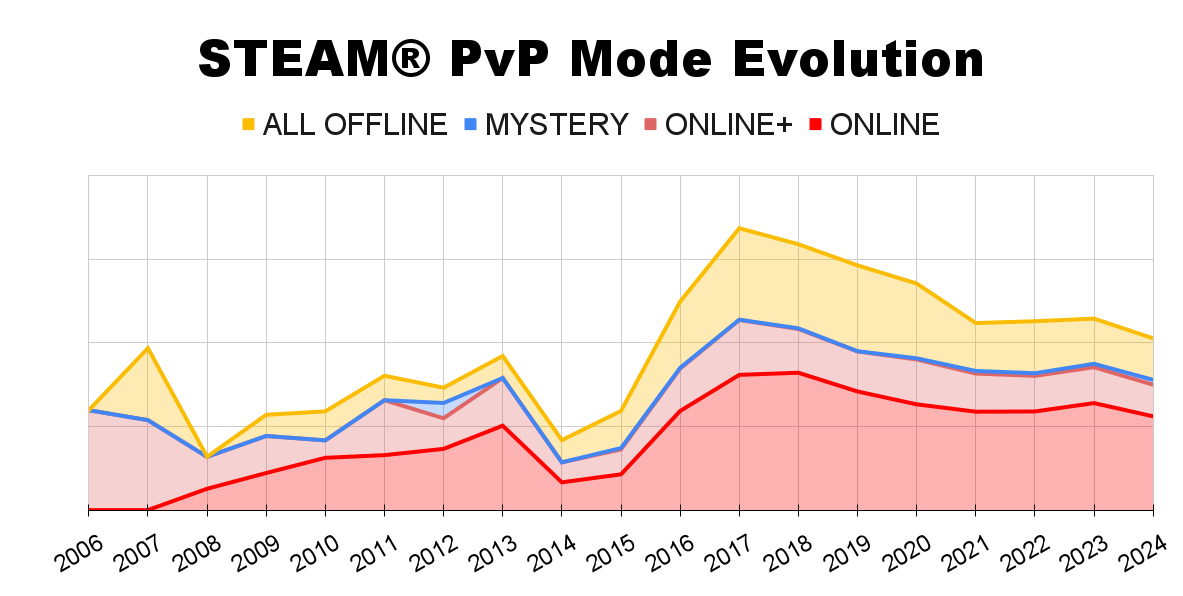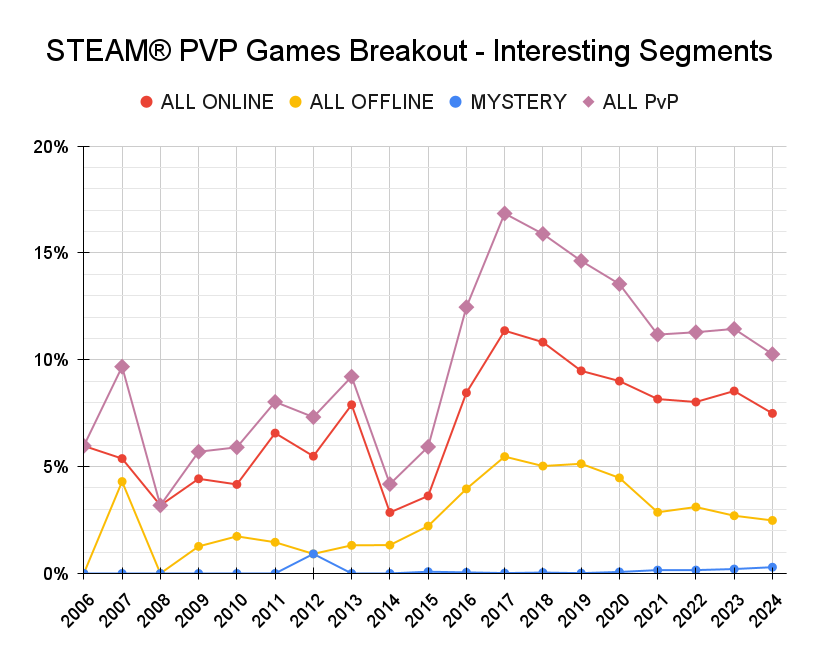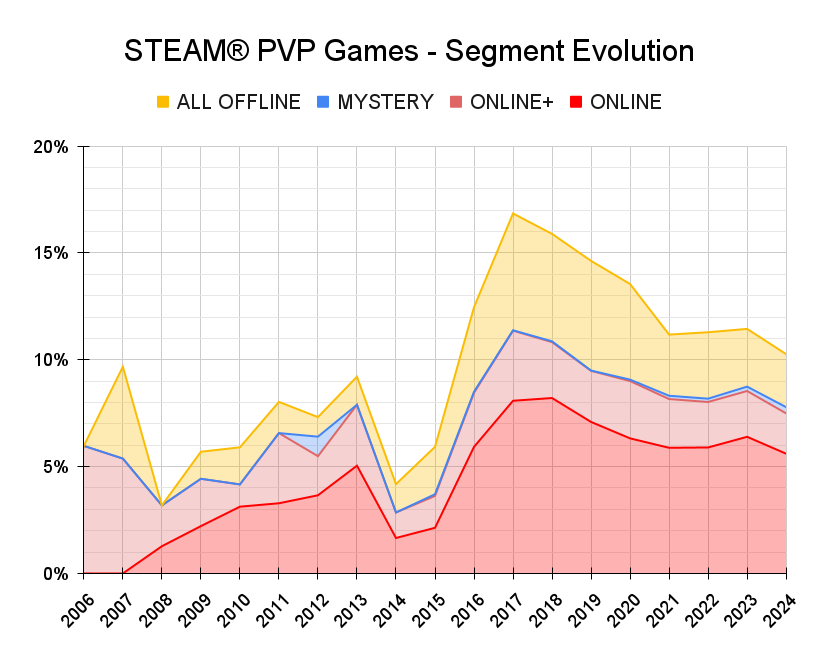INTRO
I recently published an article about STEAM co-op games — STEAM® Co-op Game Segment Evolution — motivated by a Game Developer article providing some metrics on the topic. My findings were more nuanced and detailed than the Video Game Insights (VGI) data (available by PDF, called “Rise of the Co-Op Games”) that the Game Developer article was based on.
Because the STEAM PvP category tags are a mirror to the Co-op category tags it was simple to run the same segmentation statistics for PvP game modes. I admit to being lazy. What I really mean to say is that I’m efficient. 😜 This was efficient.
Think of this article as the EVIL TWIN™️ to the Co-op article. 😈
It turns out that PvP game segment evolution is systematically different from Co-op game segment evolution.
EXECUTIVE SUMMARY
TL;DR - the absolute number of games published each year on STEAM® with some PvP feature has been rising only slowly since 2017. On the other hand the rate of all STEAM® games published each year has been climbing even faster since 2020. As a result, the overall percentage of PvP games is falling.
We see the following trends:
The percentage of shipped PvP games had a rapid, 13 point rise from 2014 through 2017.
The percentage of PvP games then fell rapidly from 2017 to 2021 by about 6 points. That percentage flattened out for 2021-2023, but as of 2024-07-31 looks to be falling another point to 10%.
PvP games with ONLINE features have always been significantly more numerous than those with OFFLINE features. The percentage decline is shared equally for both ONLINE and OFFLINE modes.
The sum of all games implementing an ONLINE PvP mode accounts for about 11% of all games in 2023 but only 10% so far in 2024.
OFFLINE PvP games may be declining faster than ONLINE PvP games as a percentage of all games.
About 1.9% of ONLINE PvP games in 2024 still include a SPLIT SCREEN and/or LAN capability.
WHAT WE EXPLORE
This article segments STEAM® ‘game’ applications using the CATEGORY tags in the JSON data pulled from the appdetails STEAM® API. The specific tags investigated are:
PvP
LAN PvP
Online PvP
Shared/Split Screen PvP
These are the same tags used to filter your game library or the store offerings in the STEAM® client or website store pages. However, when I go to the STEAM store page to look for filters, there is only one tag shown: PvP.
A quick search through some games indicates that anything with LAN PvP or Shared/Split Screen Pvp may also include the Multi-player tag.
Note that split-screen appears on its own.
GOOD SCIENCE NOTES:
LAN PvP is treated as not ONLINE — online meaning on the internet.
THE FULL MONTY
For the impatient, here is our first graph. Yes, a very busy one on a logarithmic vertical axis so you can see everything, everywhere, all at once.
Don’t worry, we’ll use the famous Blade Runner trick — “Zoom in. Enhance.” — to pull out interesting details.
If pictures and graphs are your thing, feel free to scroll ahead!
This diagram shows all possible combinations of application of the four tags listed above.
Here are the detailed segmentations in the graph above:
ALL GAMES — everything in the API labeled with type=’game’
NON PVP — games without any of the four PvP tags
ALL PVP — games with at least one of the four PvP tags
The other groupings are games with the following specific combinations of tags:
ONLINE+SPLIT+LAN — PvP, LAN PvP, Online PvP, Shared/Split Screen PvP
OLINE+LAN — PvP, LAN PvP, Online PvP
SPLIT+LAN — PvP, LAN PvP, Shared/Split Screen PvP
ONLINE+SPLIT — PvP, Online PvP, Shared/Split Screen PvP
LAN — PvP, LAN PvP
SPLIT — PvP, Shared/Split Screen PvP
ONLINE — PvP, Online PvP
MYSTERY — PvP
GOOD SCIENCE NOTES:
The “PvP” tag is apparently intended to be included for any PvP game, and should be accompanied by one of the other feature tags. The practice DOES seem to have been enforced, unlike for Co-op games of yore. However, I’ve labelled games with only a generic tag as MYSTERY so we can track them.
ALL GAMES == NON PVP + ALL PVP
ALL PVP = Sum over all the PVP games that are not MYSTERY
NORMALIZE TO PERCENTAGES
This is our first zoom and enhance step. We see that there were no games with these tags before 2006, so we skip earlier years. Because we are normalizing by all games, we drop those data. We also drop the non PvP games because they are not the focus.
However, we keep a logarithmic axis so we can visually separate the data.
This graph makes it clear that STEAM® is publishing a slowly decreasing percentage of PvP featured games every year, including so far for 2024. That decrease applies to several but not all segments.
We also see that MYSTERY games have never been a factor for PvP tagged games. 😉
THE PAST 10 YEARS
2014 is when the total number of published games surpassed 1000, and those data are less noisy. Let’s zoom and enhance!
It is interesting to see a very sudden and rapid increase in PvP games from 2014 until 2017, a three year period.
The most numerous PvP games are ONLINE or purely SPLIT screen followed by adding a SPLIT screen mode to ONLINE PvP games.
There is a minor contribution from combining ONLINE with LAN — so still ONLINE, just adding a local mode.
The ONLINE+LAN group increased from 2019 to 2021 and has remained flat since
The OLINE+SPLIT group has been slowly decreasing since 2017
We can see these trends clearly by using a stacked graph.
A BETTER SEGMENTATION
Let’s zoom back out to the full timeline, but split the population into games in four groups that provide a better overall view. Those groups are:
ALL PVP - games with any PvP tag combination
MYSTERY - games with only the generic ‘Pvp’ tag, so no specific features defined
ONLINE - games with any feature combination that includes online
OFFLINE - games with specific features but without online (LAN not considered online)
Adding together MYSTERY, ONLINE, and OFFLINE gives us ALL PVP. We can get a nice visual of the evolution of co-op features over time by using the stacked graph again. This time let’s break the ONLINE group into two subgroups - purely ONLINE, and ONLINE with additional LAN and/or SPLIT screen features — ONLINE+.
The data show a clear decline across all major segments since 2017, whether pure ONLINE, ONLINE combined with SPLIT SCREEN and/or LAN, as well as OFFLINE.
The orphaned MYSTERY games play little or no role in the equation.
GOOD SCIENCE NOTES:
The total percentage of ONLINE PvP games so far this year is very close to the total percentage of ONLINE Co-op games. This is probably just coincidence.
This year’s decline shown in the data is real may depend on whether PvP games are preferentially published after the 7th month of the year.
OUTRO
The EXECUTIVE SUMMARY covers it all, so this section will be short. :)
As a fraction of all published STEAM® games, PvP games saw a rapid increase between 2014 and 2017 of 13 points, then saw an immediate decline until 2021. They stayed flat — ish — through 2023, and may be seeing further decline in 2024.
This latter observation could depend on whether PvP games have preferential publication months after July. (See my article on STEAM® publication month preferences. 🎉)
Increases in publication rate on STEAM® do include an overall increase in PvP modes. But as a fraction of all published games, PvP is falling or just holding its own.
Is PvP mode popularity truly on a decline among game developers? Perhaps the last few months of the year will give us a hint.
RESOURCES
📖 A previous article: STEAM® Co-op Game Segment Evolution
📖 Video Game Insights report: Rise of the Co-op Games
📖 A previous article: STEAM® Offerings in 2024 Will Approach 100,000 Games
📖 A previous article: STEAM® Games: Most Popular Months
📖 A previous article: STEAM® Video Game Ratings and Mature Content
📖 A previous article: STEAM® Data Archaeology
METHODOLOGY
I’ll start putting this last for those that care, rather than up front, like in an academic publication. ;)
The data used for this investigation is the same data as the previous digs. To be specific, all STEAM® data presented here is for applications of type ‘game’ with a publication date between 2003-01-01 and 2024-07-31. The data were pulled from public STEAM® APIs. Games were segmented using the CATEGORY tags in that data.
There were a small number of games tagged with specific PvP features but without the the generic PvP tag. They were grouped with their generically tagged brethren.
CAVEAT: The game category tags investigated here are applied by, I believe, the game developers. Or at least, whoever interacts with the game’s STEAM® account. There is no easy way to verify the accuracy of the tags, but we assume that as a population they are substantially accurate.












